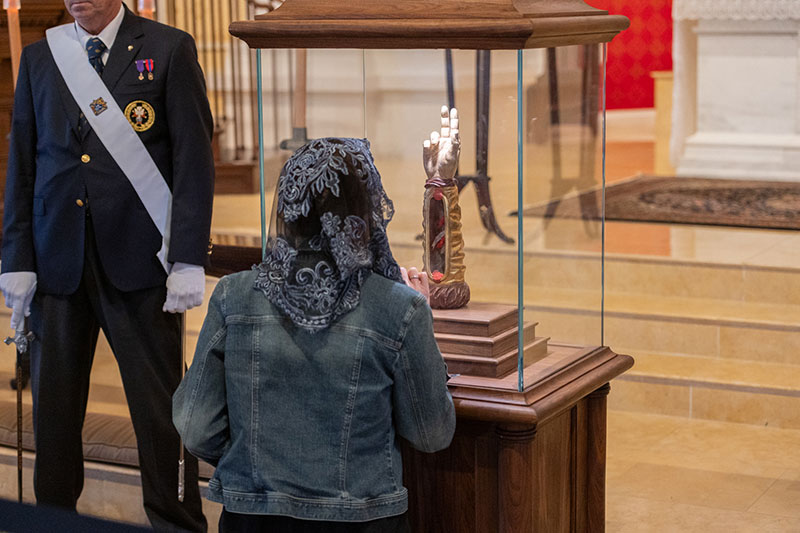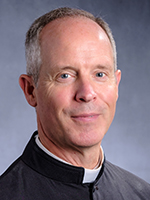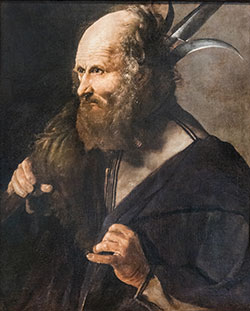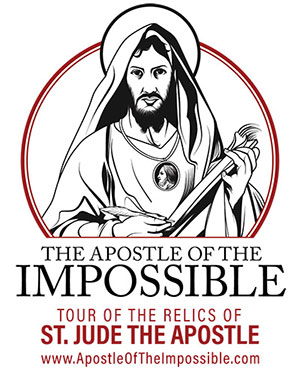"It’s very special to have this relic here because he can offer consolation and hope to so many people."
- Father Timothy Reid, pastor at St. Ann Church
 Centuries after he was martyred and his body entombed in St. Peter’s Basilica, St. Jude’s arms were removed and placed in reliquaries in the shape of a priestly arm imparting a blessing. St. Ann Church hosted one of those relics Feb. 15, when “Apostle of the Impossible: the Tour of the Relics of St. Jude the Apostle” came to Charlotte. (Photo by Troy Hull)CHARLOTTE — Thousands of people from across the Diocese of Charlotte stood in long lines outside St. Ann Church in Charlotte on Thursday, Feb. 15 to venerate a relic of St. Jude Thaddeus, one of the most beloved saints known as an intercessor for lost causes and desperate situations.
Centuries after he was martyred and his body entombed in St. Peter’s Basilica, St. Jude’s arms were removed and placed in reliquaries in the shape of a priestly arm imparting a blessing. St. Ann Church hosted one of those relics Feb. 15, when “Apostle of the Impossible: the Tour of the Relics of St. Jude the Apostle” came to Charlotte. (Photo by Troy Hull)CHARLOTTE — Thousands of people from across the Diocese of Charlotte stood in long lines outside St. Ann Church in Charlotte on Thursday, Feb. 15 to venerate a relic of St. Jude Thaddeus, one of the most beloved saints known as an intercessor for lost causes and desperate situations.
By late that night 3,200 people had turned out, according to Father Timothy Reid, pastor at St. Ann. A special evening Mass was standing room only, and so many people wanted to see the relic that viewing hours were extended to 11 p.m.
The faithful arrived in the parking lot beginning at 9 a.m., long before the relic went on display just after noon. Nearly 350 students from the parish school got the first glimpse of the relic, two large pieces of the saint’s forearm enclosed in a wood reliquary. A line of visitors wound from St. Ann’s Allen Center, outside into a courtyard, and then into the church.
It’s the first time the major relic has traveled outside of its home in Italy, with Charlotte one of three North Carolina stops on the “Apostle of the Impossible” U.S. tour, organized by Treasures of the Church evangelization ministry.
“We see crowds like this every day that we have this relic on display,” said Father Carlos Martins, who leads the ministry and has more than 30 years’ experience as a Church-appointed curator of relics. He celebrated the evening Mass dedicated to the saint.
St. Jude Thaddeus was one of the 12 apostles, and according to history, he and his fellow apostle Simon the Zealot preached in Mesopotamia, which includes present-day Iraq and parts of Iran, Kuwait, Syria and Turkey. Both apostles are believed to have been martyred around 65 A.D.
 Father ReidFather Timothy Reid, pastor at St. Ann, said it was a special honor to have such a significant relic on display at St. Ann, because St. Jude offers comfort to people dealing with difficult situations, from illness and affliction to financial and employment difficulties. He also feels a special devotion to St. Jude.
Father ReidFather Timothy Reid, pastor at St. Ann, said it was a special honor to have such a significant relic on display at St. Ann, because St. Jude offers comfort to people dealing with difficult situations, from illness and affliction to financial and employment difficulties. He also feels a special devotion to St. Jude.
“I made my first novena to St. Jude 26 or 27 years ago and my prayers at that time were answered,” Father Reid said. “It’s very special to have this relic here because he can offer consolation and hope to so many people. I’m seeing people of all ages and ethnicities here, and from all across the diocese. When I learned the relic was coming here, I left it in the Lord’s hands to bring the people here that were supposed to be here today. My hope is that if St. Jude isn’t able to completely help some of the people here, he will be able to give them grace to bear their crosses.”
Once inside the church, the faithful had a few minutes to kneel before the reliquary to pray. Many touched and pressed sacred objects such as rosaries, scapulars, medals and crucifixes to the glass.
Tim Hill traveled from Fort Mill, South Carolina, to view the relic with his son Joey Hill, 11. Hill said they talked about the saint’s history on the trip to Charlotte and he did his best to answer his son’s questions.
“I feel a lot of gratitude for being able to experience this major relic and for the chance to expose my son to this tangible evidence of our faith,” he said.
Rose Hinson, a member of St. Benedict the Moor Church in Winston-Salem, made the trip to Charlotte with two fellow parishioners.
“St. Jude is my favorite saint because he has answered many prayers for me that I can testify to,” she said.
She credits the saint with helping her find the answer to a serious health problem. Several years ago, she said, she was experiencing severe headaches that many people wrote off as “just migraines.” Unconvinced, she prayed to St. Jude and was guided to seek treatment from a neurologist, who discovered that the pain was caused by fluid on her brain that had to be removed.
Lucy Viens, a member of Our Lady of Grace Church in Greensboro, said viewing the relic was an emotional experience for her. She pressed rosaries, St. Jude medals and her prayer book to the glass surrounding the relic.
“It was really special for me to have the opportunity to see this, to realize how close this saint was to our Lord, and to pray for his intercession,” Viens said. “Just from the short time I spent there I definitely feel a growing devotion to St. Jude.”
Kristen Tarantino, who attends St. Luke Church in Mint Hill, was waiting in line with two of her children. She said she had lost her oldest son to cancer and came to pray for St.Jude’s intercession for other family members who have cancer and are dealing with other crises. She brought rosaries and family photos to touch to the glass.
“We have family members who are dealing with illness, job changes and other challenges,” she said. “I want them to have someone on the other side to pray for them and intercede for them. It’s great to have a chance to see a relic of a saint who has gone before us who can pray for us.”
— Christina Lee Knauss. Photos by Troy Hull
 Wikipedia “Saint Jude Thadddeus,” by Georges de La Tour (1620). According to ancient tradition, St. Jude and his fellow apostle St. Simon the Zealot were martyred around 65 A.D., probably in Beirut. They share a feast day, Oct. 28. St. Jude is believed to have been axed or clubbed to death, so he is often depicted holding a club and an image of Christ.Jude Thaddeus was one of Jesus’ Twelve Apostles. Little is known about him other than that he was Jesus’ cousin and had several brothers including James, another of the original Apostles.
Wikipedia “Saint Jude Thadddeus,” by Georges de La Tour (1620). According to ancient tradition, St. Jude and his fellow apostle St. Simon the Zealot were martyred around 65 A.D., probably in Beirut. They share a feast day, Oct. 28. St. Jude is believed to have been axed or clubbed to death, so he is often depicted holding a club and an image of Christ.Jude Thaddeus was one of Jesus’ Twelve Apostles. Little is known about him other than that he was Jesus’ cousin and had several brothers including James, another of the original Apostles.
The New Testament Epistle of Jude is named for him, although scripture scholars disagree on whether he was the author.
Catholics invoke St. Jude when in desperate situations because the Epistle of Jude stresses that the faithful should persevere even when facing harsh or difficult circumstances.
Historical evidence indicates Jude and fellow apostle Simon the Zealot preached in Mesopotamia, including present-day Iraq and parts of present-day Iran, Kuwait, Syria and Turkey. He and Simon are believed to have been martyred around the year 65 A.D., probably in Beirut. Their bodies were later brought to Rome and placed in a crypt in St. Peter’s Basilica.
Several centuries ago St. Jude’s arms were removed and placed in reliquaries in the shape of a priestly arm imparting a blessing.
It is one of those reliquaries – carved from wood and kept in a shrine at the Church of San Salvatore in Lauro near St. Peter’s Basilica – that pilgrims will see on the tour.
More online
At www.apostleoftheimpossible.com: Learn more about St. Jude and the U.S. tour of his relic.



















